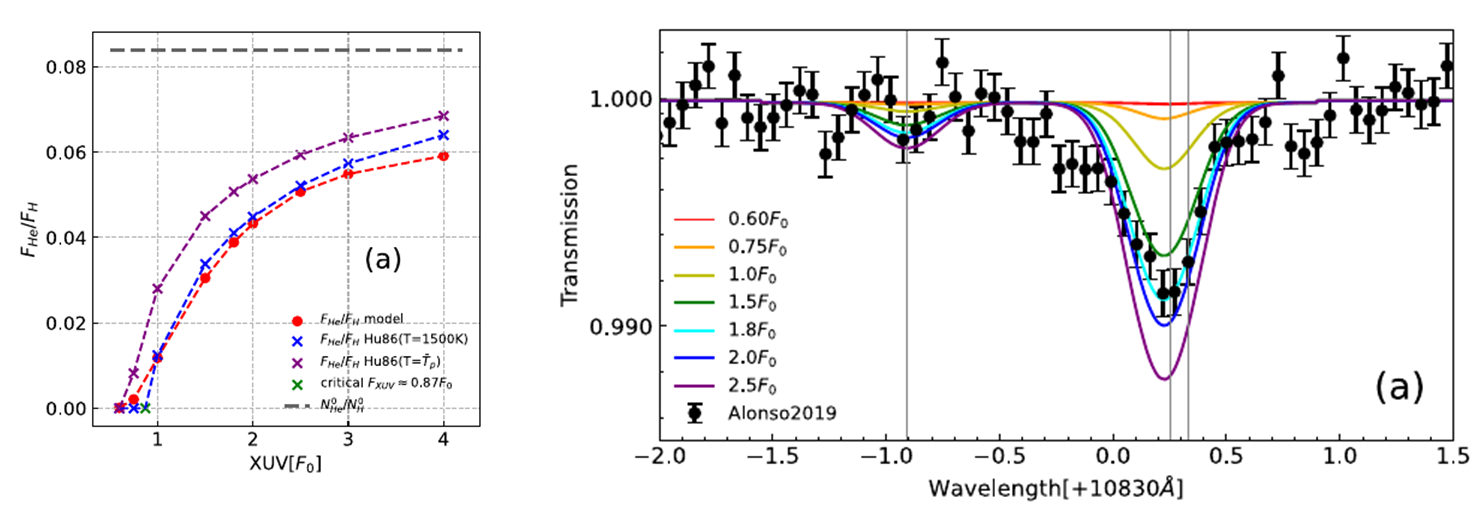Exoplanet science has been a hot research field in international astronomy over the past 20 years. The formation, evolution, and atmospheres of exoplanets remain shrouded in mystery. On some close-orbiting exoplanets, the intense X-ray and ultraviolet radiation from their host stars can trigger hydrodynamic escape of their atmospheres. In some cases, this loss of material can have a decisive impact on the course of planetary evolution.
Observation of exoplanet transmission spectrum is an important means to explore exoplanet atmosphere. Since the near-infrared band He λ 10830A spectral line is not limited by space telescopes, the transmission spectrum observation in this band provides a new window for the study of exoplanet atmosphere. Subsequent atmospheric models simulating the transmission lines of exoplanet He10830 have found that in many cases a helium-hydrogen ratio below the solar value is required, with some extreme examples such as the exoplanet HD 189733b requiring a helium-hydrogen ratio of 0.005-0.003. One possibility is that hydrogen and helium in the atmosphere decoupled, which led to helium fractionation in the planet's atmosphere.
In order to study this physical mechanism in the escaping atmosphere, Dr. XING Lei and Dr. YAN Dongdong and Professor GUO Jianheng from Yunnan Observatories, Chinese Academy of Sciences (CAS),developed the multi-fluid fluid dynamics program Pluto-XMF based on the internationally renowned magnetohydrodynamic numerical simulation program PLUTO. The program can separately track escaping of the each component in the atmosphere and the coupling process between the components. Using this procedure, they made a preliminary study of the fractionation of helium in the escaping atmosphere of the exoplanet HD 209458b (see Figure 1, left). Combining the atmospheric model with the He10830A radiative transfer model, it was found that in the best fit of the observed model, an escaping atmosphere below the helium-hydrogen ratio of the sun can spontaneously arise (see Figure 1, right). The work was published in The Astrophysical Journal. This indicates that the decoupling process of components may be a very important physical mechanism in the escape atmosphere of an exoplanet. This provides a valuable method and reference for the observation and study of the related exoplanet atmosphere.
This achievement received support from the Chinese Academy of Sciences Strategic Priority Research Program, the National Key Research and Development Program, and the National Natural Science Foundation of China.

Figure 1. The left figure shows that He/H (number density ratio) in the atmosphere gradually increases with the increase of hydrogen flow caused by the enhancement of stellar radiation, and the coupling of hydrogen and helium is gradually enhanced. The gray dashed line is the solar value, the red is the numerical simulation result, and the blue purple is the theoretical predicted value. The figure on the right shows that when the flow is 1.8 times the fiducial stellar flux, the results of the radiation transfer model are in the best agreement with the observation, and the He/H in the atmosphere at this time is 0.039, which is less than the solar value of 0.084.
Contact:
XING Lei
Yunnan Observatories, CAS
E-mail: xinglei@ynao.ac.cn